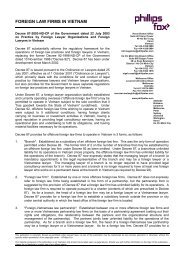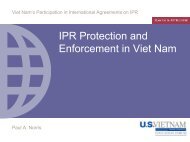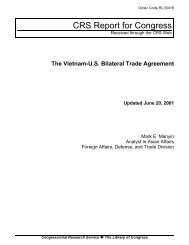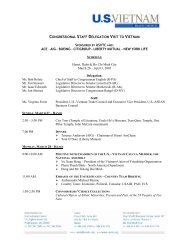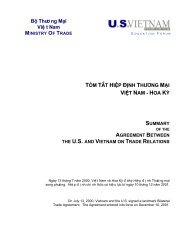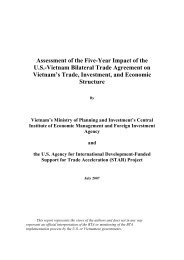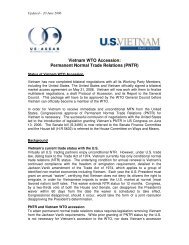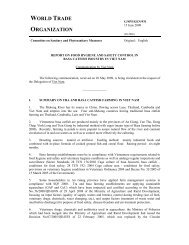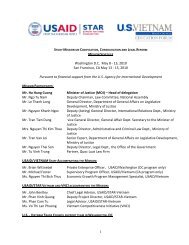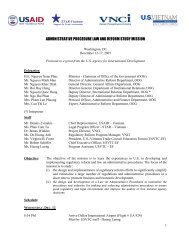mercial <strong>and</strong> <strong>in</strong>dustrial establishments, <strong>and</strong> majorpublic <strong>in</strong>frastructure). Flow damage <strong>in</strong>cluded loss of<strong>in</strong>come <strong>and</strong> <strong>in</strong>creased morbidity, which are primarilyl<strong>in</strong>ked to the duration of a flood. The damageestimates were based on data extrapolated to theKMC population <strong>in</strong> 2050. The analysis assumed noadditional <strong>in</strong>vestments <strong>in</strong> flood protection measuresthat may be implemented <strong>in</strong> the future to lowerflood damage. Inflation also was not considered,<strong>and</strong> all estimates used 2009 prices. Damage assessmentswere estimated for the 100 year flood returnperiod <strong>and</strong> the A1FI climate change scenario todeterm<strong>in</strong>e the additional damage caused by climatechange effects.Adaptation analysisF<strong>in</strong>ally, a separate analysis was done to exam<strong>in</strong>e<strong>adaptation</strong> measures <strong>in</strong> KMC that can alleviatesome of the problems posed by flood<strong>in</strong>g. Theanalysis ma<strong>in</strong>ly focused on ga<strong>in</strong>s from the completede-siltation of trunk sewers by model<strong>in</strong>g flood<strong>in</strong>gunder a completely de-silted trunk sewer scenario.The study also exam<strong>in</strong>ed other proposals to buildnew sewers <strong>and</strong> upgrade sewers <strong>in</strong> vulnerable areas,as well as <strong>in</strong>stitutional changes that can help copewith future flood damage.Ma<strong>in</strong> F<strong>in</strong>d<strong>in</strong>gsThe most vulnerable wards to climate change. Thestudy identified the most vulnerable wards to climatechange—namely, wards14, 57, 58, 63, 66, 67,74, 80, <strong>and</strong> 108. Six wards (14, 57, 58, 66, 67, <strong>and</strong>108) <strong>in</strong> the eastern part of the city <strong>and</strong> ward 80 arevulnerable because of <strong>in</strong>adequate <strong>in</strong>frastructure,unplanned l<strong>and</strong> use, <strong>and</strong> poor socioeconomic <strong>and</strong>environmental conditions. Infrastructural problemsare gett<strong>in</strong>g worse with <strong>in</strong>creased build<strong>in</strong>g activity,as these areas have become attractive to developersafter becom<strong>in</strong>g part of KMC.The other two wards—63 <strong>and</strong> 74—are highlyvulnerable due to their topography. In these wardsthe capacity of the sewerage system has not keptpace with changes <strong>in</strong> population. These have beenfurther aggravated by <strong>in</strong>adequate ma<strong>in</strong>tenance,as well as the siltation of the exist<strong>in</strong>g trunk sewersystems, which have considerably reduced their carry<strong>in</strong>gcapacity. While the sewer networks <strong>in</strong> KMCunder such partially silted condition still providereasonable hydraulic capacity for carry<strong>in</strong>g the dryweather flow, they are <strong>in</strong>adequate for carry<strong>in</strong>g stormweather flow, even with normal precipitation dur<strong>in</strong>gthe ra<strong>in</strong>y season.Additional losses likely to occur due to climatechange. Damage from a 100-year flood will <strong>in</strong>creaseby about $800 million—to more than $6.8 billion <strong>in</strong>2050—due to climate change (A1FI scenario). Theimpacts by sector (<strong>in</strong> Indian rupees at 2009 prices)are shown <strong>in</strong> the chart below. Local currency wasconverted to dollars us<strong>in</strong>g the purchas<strong>in</strong>g powerparity <strong>in</strong>dex for India of 2.88 (IMF 2009). The largestdamage components—under both the 100-yearreturn period flood <strong>and</strong> the A1FI climate changescenario—are for residential property <strong>and</strong> build<strong>in</strong>gs<strong>and</strong> health care. Commerce, <strong>in</strong>dustry, <strong>and</strong> other<strong>in</strong>frastructure like roads <strong>and</strong> transport services alsoTotal losses <strong>in</strong> major sectors <strong>in</strong> KMC (Rs million <strong>in</strong> 2050)40,00035,00030,00025,00020,00015,00010,0005,0000Residentialbuild<strong>in</strong>gResidentialpropertyResidential<strong>in</strong>come lossCommerce Industry Healthcare Roads Transport ElectricityCurrent climate 100 year floodA1F1 climate 100 year flood88 | <strong>Climate</strong> Risks <strong>and</strong> Adaptation <strong>in</strong> <strong>Asian</strong> Coastal Megacities: A Synthesis Report
susta<strong>in</strong> significant damage. Due to data constra<strong>in</strong>ts,some impacts could not be quantified <strong>in</strong> this analysis,so the estimates provided are likely to understatethe overall impact of climate change.Invest<strong>in</strong>g <strong>in</strong> de-silt<strong>in</strong>g of trunk sewers willreduce the area <strong>and</strong> population affected by floods.The study looked at the impact of <strong>in</strong>vest<strong>in</strong>g <strong>in</strong>de-silt<strong>in</strong>g trunk sewers both <strong>in</strong> the town <strong>and</strong>suburban systems of KMC. The bus<strong>in</strong>ess as usualscenario considers an average 30 percent silt<strong>in</strong>g <strong>in</strong>trunk sewers. The <strong>adaptation</strong> scenario considers<strong>in</strong>vest<strong>in</strong>g <strong>in</strong> de-silt<strong>in</strong>g <strong>and</strong> reduc<strong>in</strong>g it to zero. Thef<strong>in</strong>d<strong>in</strong>gs <strong>in</strong>dicate that this simple <strong>in</strong>vestment canreduce the area affected by a flood by 4 per cent<strong>and</strong> the population affected by floods by at least5 percent.Adaptation MeasuresThe current <strong>adaptation</strong> deficit. <strong>Climate</strong> change islikely to <strong>in</strong>tensify urban flood<strong>in</strong>g through a comb<strong>in</strong>ationof more <strong>in</strong>tense local precipitation, river<strong>in</strong>eflood<strong>in</strong>g <strong>in</strong> the Hooghly, <strong>and</strong> <strong>coastal</strong> storm surgesA major cause of such periodic flood<strong>in</strong>g dur<strong>in</strong>g thera<strong>in</strong>y season is the city’s current <strong>adaptation</strong> deficit,<strong>in</strong>clud<strong>in</strong>g deficiencies <strong>in</strong> physical <strong>in</strong>frastructure,problems with l<strong>and</strong> use, <strong>and</strong> socioeconomic <strong>and</strong>environmental factors.Adaptation strategy. The city needs a comprehensive<strong>and</strong> effective strategy that <strong>in</strong>vests <strong>in</strong>both soft <strong>and</strong> hard <strong>in</strong>frastructure to tackle flood<strong>in</strong>gproblems <strong>in</strong> Kolkata. The goal of the strategy is to (a)reduce the percentage of people affected by flood<strong>in</strong>g<strong>and</strong> sewage-related diseases <strong>in</strong> KMC, <strong>and</strong> (b)target the most vulnerable areas. The strategy should<strong>in</strong>clude preparedness both before <strong>and</strong> dur<strong>in</strong>g theevent, as well as post-event rehabilitation strategies.Invest<strong>in</strong>g <strong>in</strong> hard <strong>in</strong>frastructure. Invest<strong>in</strong>g <strong>in</strong>hard <strong>in</strong>frastructure should take <strong>in</strong>to account thefollow<strong>in</strong>g:■■The strategy needs to follow a comprehensiveapproach to plann<strong>in</strong>g that recognizes dra<strong>in</strong>agesystem complexity <strong>and</strong> <strong>in</strong>terconnectivity of its elementssuch as storm water dra<strong>in</strong>age, water supply,wastewater, water pollution control, waterreuse, soil erosion, <strong>and</strong> solid waste management.■■■■The strategy should protect major urban services,<strong>in</strong>clud<strong>in</strong>g roads, traffic, water supply, electricity,<strong>and</strong> telecommunications. It should recognizethe importance of open space <strong>and</strong> green areas asan <strong>in</strong>tegral part of city development.The strategy should spell out the climate <strong>risks</strong><strong>and</strong> mitigat<strong>in</strong>g factors needed <strong>in</strong> operationalplans for key relevant agencies.Invest<strong>in</strong>g <strong>in</strong> soft <strong>in</strong>frastructure. To ensure longtermf<strong>in</strong>ancial, <strong>in</strong>stitutional, <strong>and</strong> environmentalsusta<strong>in</strong>ability, the <strong>adaptation</strong> strategy should also<strong>in</strong>clude:■■■■■■■■■■■■■■Strengthen<strong>in</strong>g disaster management <strong>and</strong>preparedness for both pre- <strong>and</strong> post-disastersituations.Enforc<strong>in</strong>g l<strong>and</strong> use <strong>and</strong> build<strong>in</strong>g codes to reduceobstruction <strong>and</strong> encroachment of floodpla<strong>in</strong>s<strong>and</strong> environmentally sensitive areas such ascanal banks <strong>and</strong> wetl<strong>and</strong>s <strong>and</strong> to prevent conversionof green spaces <strong>and</strong> natural areas thatcan act as reta<strong>in</strong><strong>in</strong>g zones dur<strong>in</strong>g flood<strong>in</strong>g.Introduc<strong>in</strong>g susta<strong>in</strong>able f<strong>in</strong>anc<strong>in</strong>g—emphasiz<strong>in</strong>gboth cost reduction <strong>and</strong> cost recovery—for<strong>in</strong>frastructure <strong>in</strong>vestment <strong>and</strong> ma<strong>in</strong>tenance.Increas<strong>in</strong>g the budget for sewerage <strong>and</strong>dra<strong>in</strong>age ma<strong>in</strong>tenance <strong>and</strong> the allocation ofmoney for silt removal <strong>and</strong> mechanical sewerclean<strong>in</strong>g.Adopt<strong>in</strong>g flood <strong>in</strong>surance that <strong>in</strong>corporates suitable<strong>in</strong>centives for <strong>adaptation</strong> <strong>and</strong> m<strong>in</strong>imizesflood damage.Strengthen<strong>in</strong>g the regulatory <strong>and</strong> enforcementprocess, <strong>in</strong>clud<strong>in</strong>g improv<strong>in</strong>g <strong>in</strong>stitutional management<strong>and</strong> accountability.Enforc<strong>in</strong>g pollution management frameworks,<strong>in</strong>clud<strong>in</strong>g <strong>in</strong>troduction of <strong>in</strong>centives<strong>and</strong> dis<strong>in</strong>centives to ensure compliance withregulations.The government of West Bengal has alreadystarted <strong>in</strong>vest<strong>in</strong>g <strong>in</strong> <strong>adaptation</strong>. Among the suggested<strong>adaptation</strong> measures, a number of projectsare either currently under way or are plannedfor future implementation <strong>in</strong> KMA under theJawaharlal Nehru National Urban Renewal Mission(JNNURM) <strong>and</strong> the KEIP scheme funded byVulnerability of Kolkata Metropolitan Area to <strong>in</strong>creased Precipitation <strong>in</strong> a Chang<strong>in</strong>g <strong>Climate</strong> | 89



